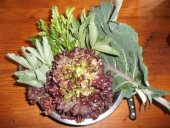
 3
3




Check out Redhawk's soil series: https://permies.com/wiki/redhawk-soil
 3
3





It's time to get positive about negative thinking  -Art Donnelly
-Art Donnelly
 5
5




John Saltveit wrote:Hi Erica,
I have lots of leafy greens at various times: horseradish leaves during the growing season, leeks during the winter and spring, shotweed cress in late winter, curly mallow in summer and fall, scorzonera in spring, that I would love to preserve for other times of the year. What are your favorite ways of preserving leafy greens to maintain texture, flavor and nutrition?
Thanks,
John S
PDX OR

Northwest Edible Life - Life on Garden Time
www.nwedible.com - nwedible @ gmail.com




nancy sutton wrote:I know that Erica will get to your question, John, and I apologize for 'cutting in' here, but it brought to mind this book I found fascinating... including it's unusual preservation info... (and highly recommended by Steve Solomon

http://www.amazon.com/Eat-Your-Greens-Surprising-Homegrown/dp/0865717516/ref=sr_1_1?s=books&ie=UTF8&qid=1444716769&sr=1-1&keywords=eat+your+greens+the+surprising+power+of+homegrown+leaf+crops
Northwest Edible Life - Life on Garden Time
www.nwedible.com - nwedible @ gmail.com
 2
2




Erica Strauss wrote:...drying on low temperature, and then making typically a kind of DIY "greens powder" that can be added to soups or smoothies...
Pecan Media: food forestry and forest garden ebooks
Now available: The Native Persimmon (centennial edition)
 3
3




 3
3




Check out Redhawk's soil series: https://permies.com/wiki/redhawk-soil
 1
1




John Saltveit wrote:Hi Honor,
Do you ferment the grape leaves whole?
 6
6




Trying to achieve self-reliance on a tiny suburban plot: http://gardenofgaladriel.blogspot.com
 2
2




 2
2




 1
1




 2
2




Permaculture and Homestead Blogging on the Traditional Catholic Homestead in Idaho! Jump to popular topics here: Propagating Morels!, Continuous Brew Kombucha!, and The Perfect Homestead Cow!









 3
3




Permaculture and Homestead Blogging on the Traditional Catholic Homestead in Idaho! Jump to popular topics here: Propagating Morels!, Continuous Brew Kombucha!, and The Perfect Homestead Cow!








 2
2




 6
6




Check out Redhawk's soil series: https://permies.com/wiki/redhawk-soil




 2
2




Projects, plans, resources - now on the Permies.com digital marketplace.
Try the Everything Combo as a reference guide.
 2
2




Check out Redhawk's soil series: https://permies.com/wiki/redhawk-soil





 4
4




 NETTLES
NETTLES  Some have mentioned nettles, and some have asked if the nettles lose their sting with certain methods. Here's the thing about a nettle stinger: It is a very (I mean extremely) delicate tube containing a liquid acid that reacts with your skin when it brushes against you. If the nettle is frozen, fermented, dried, crushed or blended, fried, roasted, baked or sauteed, steamed, boiled, simmered, or steeped, or even quickly dipped in hot water (this last is how many NW coastal First Nations ate them), all those tubes become non effective. Experiment with it. Try dipping some in hot water and observe those little hairs. They basically disappear. Drying: same. They are completely folded down to nothing of substance. JUICED !!! no problems. The nettle acid in the tubes is such as small volume compared to the rest of the volume of the leaves and stems that once broken down with any of the above methods, it is pretty much completely neutralized (or at least diluted to the point of non harm), to my knowledge (which is decent) and experience (which is substantial enough).
Some have mentioned nettles, and some have asked if the nettles lose their sting with certain methods. Here's the thing about a nettle stinger: It is a very (I mean extremely) delicate tube containing a liquid acid that reacts with your skin when it brushes against you. If the nettle is frozen, fermented, dried, crushed or blended, fried, roasted, baked or sauteed, steamed, boiled, simmered, or steeped, or even quickly dipped in hot water (this last is how many NW coastal First Nations ate them), all those tubes become non effective. Experiment with it. Try dipping some in hot water and observe those little hairs. They basically disappear. Drying: same. They are completely folded down to nothing of substance. JUICED !!! no problems. The nettle acid in the tubes is such as small volume compared to the rest of the volume of the leaves and stems that once broken down with any of the above methods, it is pretty much completely neutralized (or at least diluted to the point of non harm), to my knowledge (which is decent) and experience (which is substantial enough).

"Never doubt that a small group of thoughtful, committed citizens can change the world; indeed, it's the only thing that ever has."-Margaret Mead "The only thing worse than being blind, is having sight but no vision."-Helen Keller
 4
4




 10
10




If you can move it an inch, you can move it a mile. Just expect it to take a little longer.

|
a tiny voice in my head can't shut up about this tiny ad:
The new gardening playing cards kickstarter is now live!
https://www.kickstarter.com/projects/paulwheaton/garden-cards
|







